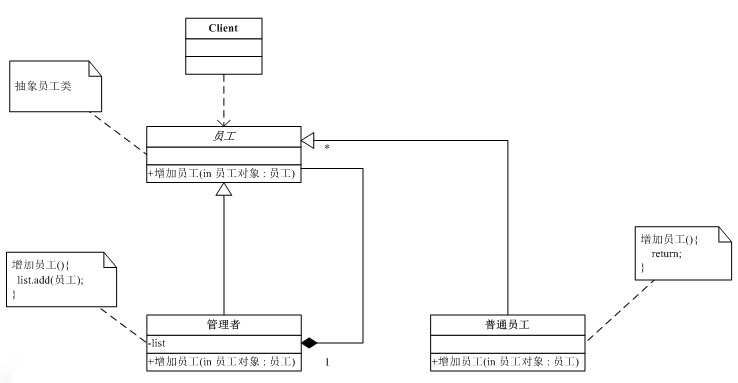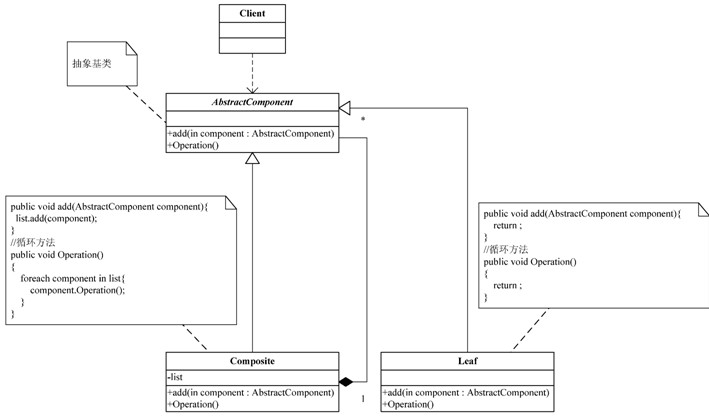怎么在Java中利用组合模式实现公司组织结构功能?相信很多没有经验的人对此束手无策,为此本文总结了问题出现的原因和解决方法,通过这篇文章希望你能解决这个问题。
一、模式定义
组合模式:将对象组合成树形结构以表示“部分一整体”的层次结构,组合模式使得用户对单个对象和组合对象的使用具有一致性。
二、组合模式举例
1 模式分析
我们借用公司组织结构图来说明这一模式。
经过分析后,我们得出该模式静态类图如下:

2 代码示例
2.1 建立员工抽象类
package com.demo.composite; /** * 职工类接口 * * @author * */ public abstract class Staff { // 员工号 protected String no; // 职工名字 protected String name; // 职位 protected String position; // 薪资 protected float salary; // 私有属性 长度字符串 private int length; // 构造方法 public Staff(String no, String name, String position, float salary) { this.no = no; this.name = name; this.position = position; this.salary = salary; // 计算总字节长度 this.length += (no == null || "".equals(no.trim())) ? 0 : no.getBytes().length; this.length += (name == null || "".equals(name.trim())) ? 0 : name .getBytes().length; this.length += (position == null || "".equals(position.trim())) ? 0 : position.getBytes().length; this.length += String.valueOf(salary).getBytes().length; } // 获得用户基本信息 public void printUserBaseInfo() { System.out.println("|" + this.no + " " + this.name + " " + this.position + " " + this.salary); } // 添加员工信息 public abstract void add(Staff staff); // 删除员工 public abstract Staff remove(String no); // 打印员工信息 public abstract void printEmployeesInfo(int layer); // 打印若干字符 protected void printChar(int layer) { for (int j = 0; j < layer * 2; j++) { System.out.print("-"); } } // 私有方法打印一行 protected void printLine() { System.out.print("+"); for (int i = 0; i < this.length + 4; i++) { System.out.print("-"); } System.out.println("-"); } public String getNo() { return no; } public void setNo(String no) { this.no = no; } public String getName() { return name; } public void setName(String name) { this.name = name; } public String getPosition() { return position; } public void setPosition(String position) { this.position = position; } public float getSalary() { return salary; } public void setSalary(float salary) { this.salary = salary; } }2.2 创建管理者
package com.demo.composite.sub; import java.util.ArrayList; import com.demo.composite.Staff; /** * 管理人员(手下有其他员工的人) * * @author * */ public class Manager extends Staff { // 存储手下员工信息 private final ArrayList<Staff> arrayList = new ArrayList<Staff>(); // 构造方法 public Manager(String no, String name, String position, float salary) { super(no, name, position, salary); } /** * 增加一个员工 */ @Override public void add(Staff staff) { this.arrayList.add(staff); } /** * 删除员工信息 */ @Override public Staff remove(String no) { Staff staff = null; if (no != null && !"".equals(no.trim())) { for (int i = 0; i < this.arrayList.size(); i++) { if (this.arrayList.get(i) == null) { continue; } if (no.equals(this.arrayList.get(i).getNo())) { staff = this.arrayList.remove(i); break; } } } return staff; } /** * 打印员工信息 */ @Override public void printEmployeesInfo(int layer) { int tmpLayer = ++layer; for (int i = 0; i < this.arrayList.size(); i++) { if (this.arrayList.get(i) == null) { continue; } // 打印'-' printChar(tmpLayer); // 打印员工基本信息 this.arrayList.get(i).printUserBaseInfo(); // 打印手下员工信息 this.arrayList.get(i).printEmployeesInfo(tmpLayer); } } }2.3 创建普通员工
package com.demo.composite.sub; import com.demo.composite.Staff; /** * 普通员工(真正干活的人) * * @author * */ public class Employees extends Staff { // 构造方法 public Employees(String no, String name, String position, float salary) { super(no, name, position, salary); } /** * 添加员工信息 */ @Override public void add(Staff staff) { return; } /** * 删除员工信息 */ @Override public Staff remove(String no) { // 直接返回null return null; } /** * 打印员工信息 */ @Override public void printEmployeesInfo(int layer) { return; } }2.4 客户端测试
package com.demo; import com.demo.composite.Staff; import com.demo.composite.sub.Employees; import com.demo.composite.sub.Manager; /** * 主应用程序 * * @author * */ public class Client { /** * @param args */ public static void main(String[] args) { // 公司CEO Staff boss = new Manager("1", "大老板", "CEO", 100000); /** * CEO手下有若干部门经理 */ // 财务部经理 Staff financeManager = new Manager("11", "张总", "财务部经理", 60000); // 人事部经理 Staff personnelManager = new Manager("12", "王总", "人事部经理", 60000); // 技术部经理 Staff technicalManager = new Manager("13", "陈总", "技术部经理", 60000); /** * 技术部门还有助理和若干主管 */ // 技术部门助理 Staff deptAssistant = new Manager("1301", "王助理", "部门助理", 20000); // 技术部门主管1 Staff deptManager1 = new Manager("1302", "主管1", "技术主管", 30000); /** * 技术主管deptManager1 下面还有软件工程师(最终干活的人) */ Staff softwareEngineer1 = new Employees("1302001", "张三", "软件工程师", 5000); Staff softwareEngineer2 = new Employees("1302002", "李四", "软件工程师", 5500); Staff softwareEngineer3 = new Employees("1302003", "王五", "软件工程师", 4500); // 为技术主管1添加员工信息 deptManager1.add(softwareEngineer1); deptManager1.add(softwareEngineer2); deptManager1.add(softwareEngineer3); // 技术部门主管2 Staff deptManager2 = new Manager("1303", "主管2", "技术主管", 30000); // 为技术部经理 添加:部门助理、技术主管1和技术主管2 technicalManager.add(deptAssistant); technicalManager.add(deptManager1); technicalManager.add(deptManager2); // 市场部经理 Staff marketingManager = new Manager("14", "吴总", "市场部经理", 60000); // 为CEO 添加:财务部经理、人事部经理、技术部经理和市场部经理 boss.add(financeManager); boss.add(personnelManager); boss.add(technicalManager); boss.add(marketingManager); // 打印CEO 信息 boss.printUserBaseInfo(); // 打印CEO 手下员工信息 boss.printEmployeesInfo(1); } }运行结果如下:
|1 大老板 CEO 100000.0
----|11 张总 财务部经理 60000.0
----|12 王总 人事部经理 60000.0
----|13 陈总 技术部经理 60000.0
------|1301 王助理 部门助理 20000.0
------|1302 主管1 技术主管 30000.0
--------|1302001 张三 软件工程师 5000.0
--------|1302002 李四 软件工程师 5500.0
--------|1302003 王五 软件工程师 4500.0
------|1303 主管2 技术主管 30000.0
----|14 吴总 市场部经理 60000.0
三、该模式设计原则
1 统一对待个别对象和组合对象
2 面向抽象编程
四、使用场合
1 想表示对象的“部分一整体”层次结构的时候。
2 希望用户忽略组合对象与单个对象的不同,用户将统一使用组合结构中所有对象的时候。
组合模式的静态类图如下

Java中的集合主要分为四类:1、List列表:有序的,可重复的;2、Queue队列:有序,可重复的;3、Set集合:不可重复;4、Map映射:无序,键唯一,值不唯一。
看完上述内容,你们掌握怎么在Java中利用组合模式实现公司组织结构功能的方法了吗?如果还想学到更多技能或想了解更多相关内容,欢迎关注亿速云行业资讯频道,感谢各位的阅读!
免责声明:本站发布的内容(图片、视频和文字)以原创、转载和分享为主,文章观点不代表本网站立场,如果涉及侵权请联系站长邮箱:is@yisu.com进行举报,并提供相关证据,一经查实,将立刻删除涉嫌侵权内容。